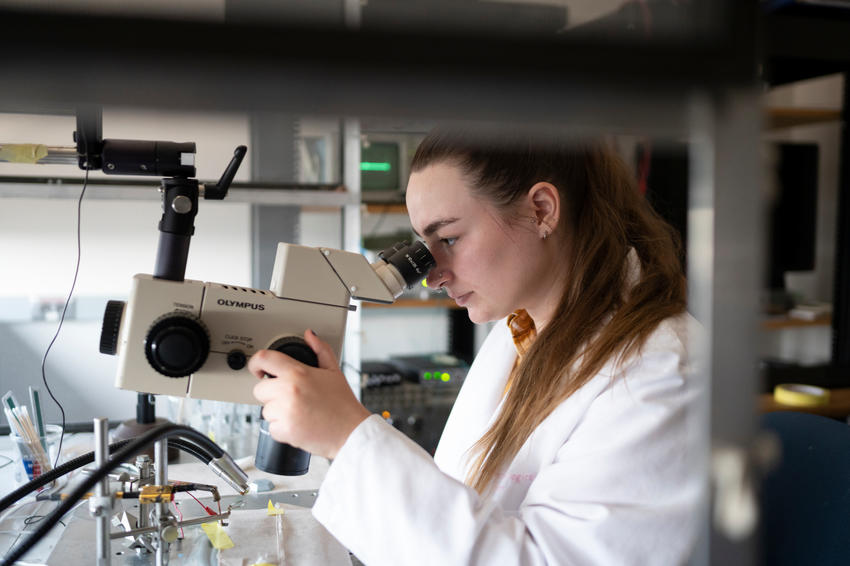Discovery that impacts lives | 18th Annual Research Day

The 18th annual Research Day at the University of Minnesota School of Dentistry, held Friday, March 4, brought together experts across disciplines from the University of Minnesota and beyond to discuss cutting-edge discoveries in oral biology, cancer treatment and prevention and more.
“Dr. Bereiter and the Continuing Dental Education team have put together a wonderful program for us today,” said Dean Keith Mays, DDS, MS, PhD, as he kicked off the day’s events. Interim Associate Dean for Research David Bereiter, PhD, agreed, reflecting on the “robust group of researchers and providers” represented at Research Day and housed in the School of Dentistry generally.
Before showcasing a variety of the school’s expertise in presentations throughout the day, Dean Mays kicked off the event by introducing keynote speaker Janice Lee, DDS, MD, FACS. Lee is the clinical director and chief of the Craniofacial Anomalies and Regeneration Section NIDCR, and deputy director for intramural clinical research at the National Institutes of Health. She received her DDS and MS in oral biology from the UCLA School of Dentistry and her MD from Harvard Medical School before completing her residency in general surgery and oral and maxillofacial surgery at Massachusetts General Hospital and a post-doctoral fellowship at the NIDCR. Lee is an expert in surgery, translational research and the pioneering field of craniofacial developmental anomalies and bone regeneration.
In her keynote presentation, Lee outlined her research on predicting craniofacial development and growth based on phenosequencing. Presenting two case studies—one of a seventeen year old female whose profile seemed unique to her but was quantitatively proven to be inherited from her father, and one of TGF beta pathways in Loeys-Dietz Syndrome—Lee shared her methods of phenotyping, combined with quantitative 3D analysis, and how she and her team are working to predict growth outcomes that previously could not be determined.
“When you have to tell a family that their child needs surgery, the parents start to ask questions: how did this happen? Why did this happen? Will it happen to my other kids?,” Lee explained, outlining why she chose to pursue this question. “It was quite distressing, realizing that with all our technology, I couldn’t give a good answer to those questions. I’ve always had a fascination with craniofacial development, and at the NIH, I can work with the whole family and study this.”
Lee’s presentation was followed by several studies from School of Dentistry faculty, sharing how they are using their expertise to answer questions with great clinical impact. Mark Herzberg, DDS, PhD, shared his data on the use of Calprotectin to diminish the impact of oral cancer, and how his lab is using the same mRNA technology used to develop the COVID-19 vaccines and applying it therapeutically to push back against cancer formation in the head and neck. “Oral cancer is a global problem,” Herzberg explained. “Calprotectin contributes to virtually all of the anti-tumor properties: low tumor grade, decreased cell growth, higher survival rates. We’re working to establish calprotectin as a good on-target chemotherapeutic approach.”
Following Herzberg’s research, attendees heard presentations from nine oral biology student researchers and seven DDS student summer researchers. Presentations ran the gamut from studies of pathogens causing experimental periodontitis to rapid non-invasive tests for the early detection of neuropathy. Often a favorite of attendees, these presentations demonstrated the depth and breadth of knowledge and discovery with which our students engage during their DDS and graduate studies.
Bruno Lima, DDS, PhD, then presented on collagenase production by Streppococcus mutans and its role in dentin degradation, sharing his lab’s work to decrease the occurrence of secondary caries, increase the longevity of restorations and, in his words, “make patients a lot happier with our work.” Donald Nixdorf, DDS, MS, considered whether dentistry is ready to incorporate MRI into practice by sharing a number of studies he and his colleagues have pursued in attempts to democratize MRI and study its applicability in dental settings. Cyndee Stull, MSDH, DHSc, shared her research on opportunities for protection and early detection of HPV-associated oropharyngeal cancer and the role of oral health providers in this fight.
“The dental professional has a responsibility to educate, prevent, advocate and collaborate to stop HPV-associated oropharyngeal cancer.” Stull shared insights on her studies of motivational interviews led by dental providers, as well as a pilot study of communications-based training for providers counseling their patients on the immunization.
Finally, Paul Olin, DDS, MS, shared his work over the past two years on aerosols in the dental cubicle and making dentistry safe during the COVID-19 pandemic. “Early on, we had a lot of questions,” Olin reflected. “We were told dentistry was high risk, but we didn’t know much about aerosols yet. We had PPE, but it was created for blood-borne pathogens. We needed to know whether we were doing enough, and what we could do to keep ourselves and our patients safe.” Olin spoke to his work with virology researcher Paul Jardine, PhD, and other dental faculty on viral spread, as well as partnerships with engineering faculty using digital inline holography during high-speed drilling and other procedures. He referenced his recently-published paper in the Journal of the American Dental Association as well as ongoing studies of mitigation and infection.
Though spanning across areas of expertise and methodology, this year’s Research Day presentations had some things in common: a passion for discovery, a drive for discipline and above all, a commitment to research that has real, tangible and lasting impacts on the lives of patients–both today and in the future.
A recorded version of this year’s Research Day presentation will be made available at a later date on CDE Anytime.